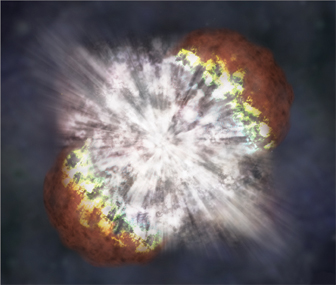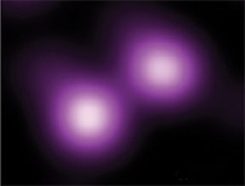A great ball of fire
Astronomers are marveling at what may be the hugest, most spectacular star explosion ever recorded.
Share this:
- Share via email (Opens in new window) Email
- Click to share on Facebook (Opens in new window) Facebook
- Click to share on X (Opens in new window) X
- Click to share on Pinterest (Opens in new window) Pinterest
- Click to share on Reddit (Opens in new window) Reddit
- Share to Google Classroom (Opens in new window) Google Classroom
- Click to print (Opens in new window) Print
By Emily Sohn
It’s a bird! It’s a plane! No, it’s the hugest, most spectacular star explosion ever recorded. And astronomers are marveling at what they’ve just seen.
 |
|
The supernova called SN 2006gy, drawn here by an artist, is the brightest exploding star ever noticed by astronomers.
|
| NASA |
When a really big star (some are 10 times as big as our sun) runs out of fuel, it dies in a dramatic explosion. Astronomers call this a supernova. Scientists have observed supernovas before, but this latest outburst had 100 times as much energy as a typical explosion. In just 2 months, it spit out more radiation than the sun will emit during its 10-billion-year lifetime.
Calculations suggest that the star that exploded was more than 150 times as massive as our sun. That makes it the heaviest star on record. (For comparison, our sun is more than 333,000 times more massive than Earth.)
Two teams of scientists — one led by researchers from the University of California, Berkeley, the other led by researchers from the California Institute of Technology in Pasadena — recently announced their observations of the eruption. The event is being called SN 2006gy. (SN stands for supernova.) Astronomers had first observed the SN 2006gy last September. It lies in a galaxy 240 million light-years from Earth.
 |
|
An X-ray image shows that the supernova (top right) is as bright as the center of its home galaxy (bottom left).
|
| CSX |
Because of SN 2006gy’s immense size, astronomers’ usual theories of star death don’t work. One popular theory, for example, says that after a supernova has blown off its steam, its core collapses. This new superdense core may be a neutron star or a black hole. But that model can’t account for the extreme brightness of SN 2006gy.
Instead, the two teams that reported the blast propose that the huge star’s core was unusually hot. That heat, they think, caused high-energy gamma rays inside the core to destroy each other. Gamma rays are a type of high energy radiation. And they help keep stars intact. So their destruction made the star unstable. The star would have then collapsed and blown up, leaving nothing behind but a huge, very bright explosion.
This type of supernova, called a “pair-instability supernova,” was probably common among the universe’s very first stars, scientists now suspect. SN 2006gy may then be a rare, modern example of an ancient phenomenon. Eta Carinae, a star in our own galaxy, might be poised to undergo the same type of explosion, researchers say.
But there are also some problems with the pair-instability model, and still other theories are possible. For example, Stan Woosley works at the University of California, Santa Cruz. He proposes that a series of instabilities over the course of a year, rather than one single huge explosion, spewed material out of the dying star. The final blast would have then lit up all the previously ejected material. Woosley’s theory would explain the brightness without requiring that the star be freakishly large.
Whatever the explanation for the explosion, the display it left behind was out of this world.
Going Deeper:
Cowen, Ron. 2007. Stellar spectacular: Brightest supernova. Science News 171(May 12):293. Available at http://www.sciencenews.org/articles/20070512/fob5.asp .
Sohn, Emily. 2006. Dead star exploding. Science News for Kids (Aug. 9). Available at http://www.sciencenewsforkids.org/articles/20060809/Note2.asp .
______. 2006. Spotlight on an exploding star. Science News for Kids (March 8). Available at http://www.sciencenewsforkids.org/articles/20060308/Note3.asp .







